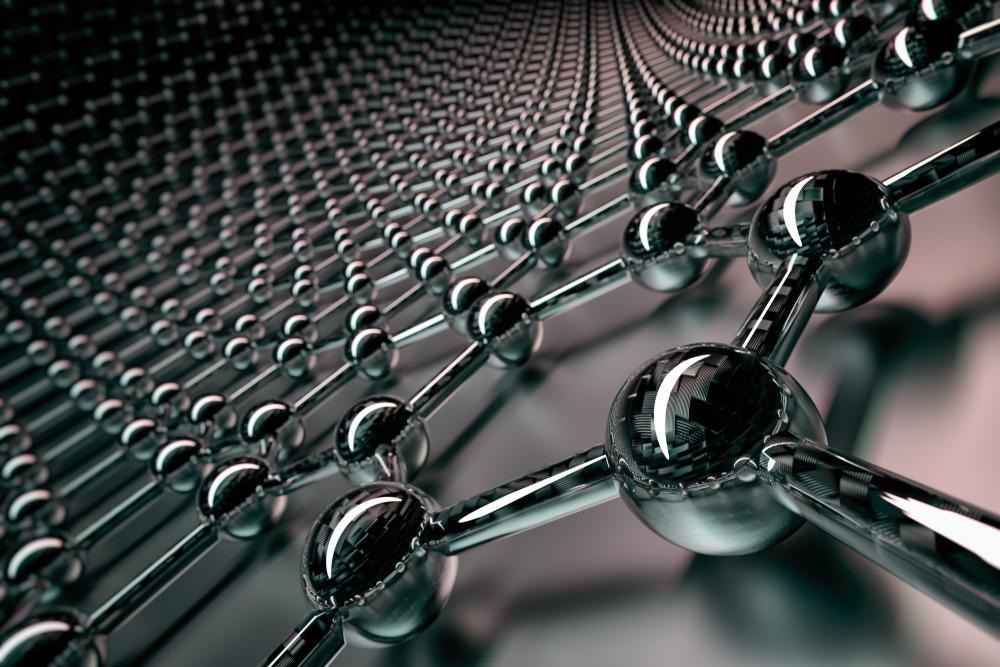In a paper printed in The Journal of Physical Chemistry Letters, several optical approaches, paired with a laser direct writing technique, were utilized to photowrite and erase a well-defined chemical pattern on a graphene canvas with a spatial resolution of roughly 300 nm.

Study: All-Optical and One-Color Rewritable Chemical Patterning on Pristine Graphene under Water. Image Credit: Forance/Shutterstock.com
Characteristics of Graphene
Graphene has received much interest as an exciting two-dimensional substance for a wide variety of uses, including electrical applications, (opto-) electronic gadgets, and high radio frequency devices, as well as energy storage and biological devices. This is because of its extremely thin structure, exceptional mechanical durability and elasticity, heat resistance, strong interfacial electron mobility, superior optical features, and bandgap engineering adaptability.
A critical role in expanding the bandgap in graphene and altering its exceptional characteristics is played by the introduction of sp3-type faults, also known as chemical/functional deficiencies.
Graphene's chemical, optoelectronic, and electrical properties can be tailored in a site-specific way by spatially distributed functionalization. This enables the customization of hydrophilicity and wettability, catalyzed or optoelectronic action, molecular attachment, and electron permittivity, to name a few. As a result, more advanced approaches for spatially precise chemical functionalization and subsequent chemical patterning on graphene sheets are being created.
Previous Methods Used for Chemical Pattering
If particular circumstances are met, sp3-type flaws on a graphene monolayer may be converted to sp2 carbon, as opposed to other forms of problems such as void, borderline, and corner flaws.
The chemical patterning of graphene monolayers has been described in several prior studies. Successive defunctionalization of the chemically synthesized graphene provides a different method for bidirectional tuning over the data on graphene, which has previously been unavailable. In most instances, however, thermal and chemical repair of molecular flaws on graphene monolayers has only been performed in a randomized and uncontrolled way.
The laser direct writing approach, in conjunction with laser-induced thermal defunctionalization, has been used to defunctionalize a chemically produced graphene oxide layer on a location basis.
No such all-optical technique has been documented so far. By meeting the particular requirement for the rewritable and flexible design of structured graphene structures, such all-optical approaches might open up new advanced capabilities.
Benefits of an All-Optical Method
In this paper, an all-optical method for rewritable chemical patterning of graphene monolayers was described that used one-color laser-induced photo functionalization/defunctionalization in conjunction with the laser direct writing techniques.
Some prior work has been undertaken on the simple photo-functionalization of the graphene monolayer, which is a promising technique. Photo-oxidation is caused by the reaction of laser-induced positively charged ions with sp2 carbon atoms in graphene due to the intense excitation of electrons.
This straightforward procedure requires no additives or chemical agents, simply water. In this regard, photo-oxidation in the presence of moisture is pure, ecologically beneficial, and appropriate for the individuals engaged. Photo-oxidation is also inexpensive, adaptable, and intriguing for spatial control over graphene chemical functionalization.
By precisely concentrating a laser on the water contact at any preferred location with a dispersion restricted spatial precision, arbitrary chemical patterning on pure graphene was realized on a nanoscale scale. The created chemical sequence was subsequently viewed using Raman mapping with a similar stimulation beam but a tenfold lower laser intensity.
Outcomes of the Research
A simple approach for chemically reversible patterning of monolayer graphene was presented in this study. Graphene could be effectively and quickly oxidized through the use of short-wavelength visual CW laser ablation.
This was accomplished through the transport of conduction electrons from graphene to oxidants dissolved in water. It was also proved that by warming while affecting the amount of intensity of the same ignition laser, this photo-oxidation area could be selectively reverted to pure graphene.
Coupling photo-oxidation and the laser direct writing approach allowed for the creation of chemical functionalization patterning on graphene canvases. The focal length of these structures (300 nm) was dictated by the laser focus point size. Raman mapping using the same illumination laser was used to figure out the chemical designs inscribed on the graphene canvases.
The method described in this research enabled people working in this field to accurately adjust the chemical functionalization in a spatially distributed way, paving the way for further advancements in the productive customization of graphene characteristics.
Reference
Toyouchi, S., Wolf, M., Feng, G., Fujita, Y., & Uji-i, H. (2022). All-Optical and One-Color Rewritable Chemical Patterning on Pristine Graphene under Water. The Journal of Physical Chemistry Letters. Available at: https://pubs.acs.org/doi/10.1021/acs.jpclett.2c00446
Disclaimer: The views expressed here are those of the author expressed in their private capacity and do not necessarily represent the views of AZoM.com Limited T/A AZoNetwork the owner and operator of this website. This disclaimer forms part of the Terms and conditions of use of this website.